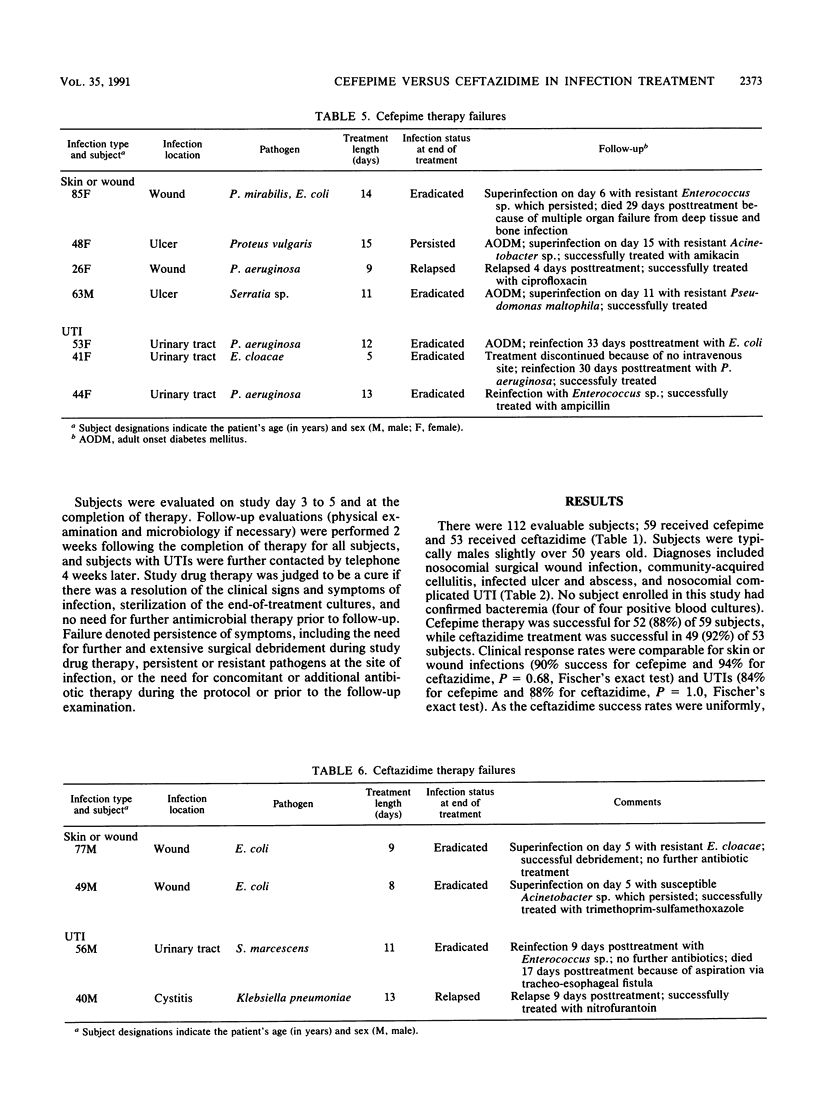Abstract
We undertook a prospective, randomized open comparison of the broad-spectrum cephalosporins cefepime and ceftazidime in treatment of hospitalized subjects with skin or wound infections and complicated nosocomial urinary tract infections. Cefepime treatment (dosage, 2.0 g intravenously twice daily for 4 to 28 days) was successful in 36 (90%) of 40 infections of the skin and skin structure or wounds and in 16 (84%) of 19 nosocomial urinary tract infections. Ceftazidime treatment, 2.0 g every 8 h, was successful in 34 (96%) of 36 infections of the skin and skin structure and in 15 (88%) of 17 urinary tract infections. Microbiological eradication rates of each agent overall and for Pseudomonas aeruginosa were greater than 90%. In the cefepime group, one death occurred, contributed to by an enterococcal superinfection acquired during study drug therapy, and there were two mild and transient adverse experiences observed. Cefepime was comparable to ceftazidime in treatment of infections of the skin and skin structure requiring hospitalization and of complicated nosocomial urinary tract infections.
Full text
PDF



Selected References
These references are in PubMed. This may not be the complete list of references from this article.
- Fuchs P. C., Jones R. N., Barry A. L., Ayers L. W., Gavan T. L., Gerlach E. H. In vitro activity of carumonam (RO 17-2301), BMY-28142, aztreonam, and ceftazidime against 7,620 consecutive clinical bacterial isolates. Diagn Microbiol Infect Dis. 1986 Nov;5(4):345–349. doi: 10.1016/0732-8893(86)90041-6. [DOI] [PubMed] [Google Scholar]
- Fuchs P. C., Jones R. N., Barry A. L., Thornsberry C. Evaluation of the in vitro activity of BMY-28142, a new broad-spectrum cephalosporin. Antimicrob Agents Chemother. 1985 May;27(5):679–682. doi: 10.1128/aac.27.5.679. [DOI] [PMC free article] [PubMed] [Google Scholar]
- Fung-Tomc J., Dougherty T. J., DeOrio F. J., Simich-Jacobson V., Kessler R. E. Activity of cefepime against ceftazidime- and cefotaxime-resistant gram-negative bacteria and its relationship to beta-lactamase levels. Antimicrob Agents Chemother. 1989 Apr;33(4):498–502. doi: 10.1128/aac.33.4.498. [DOI] [PMC free article] [PubMed] [Google Scholar]
- Fung-Tomc J., Huczko E., Pearce M., Kessler R. E. Frequency of in vitro resistance of Pseudomonas aeruginosa to cefepime, ceftazidime, and cefotaxime. Antimicrob Agents Chemother. 1988 Sep;32(9):1443–1445. doi: 10.1128/aac.32.9.1443. [DOI] [PMC free article] [PubMed] [Google Scholar]
- Neu H. C., Chin N. X., Jules K., Labthavikul P. The activity of BMY 28142 a new broad spectrum beta-lactamase stable cephalosporin. J Antimicrob Chemother. 1986 Apr;17(4):441–452. doi: 10.1093/jac/17.4.441. [DOI] [PubMed] [Google Scholar]
- Rolston K. V., Alvarez M. E., Hsu K. C., Bodey G. P. In-vitro activity of cefpirome (HR-810), WIN-49375, BMY-28142 and other antibiotics against nosocomially important isolates from cancer patients. J Antimicrob Chemother. 1986 Apr;17(4):453–457. doi: 10.1093/jac/17.4.453. [DOI] [PubMed] [Google Scholar]
- Tsuji A., Maniatis A., Bertram M. A., Young L. S. In vitro activity of BMY-28142 in comparison with those of other beta-lactam antimicrobial agents. Antimicrob Agents Chemother. 1985 Apr;27(4):515–519. doi: 10.1128/aac.27.4.515. [DOI] [PMC free article] [PubMed] [Google Scholar]
- Vuye A., Pijck J. In vitro antibacterial activity of BMY-28142, a new extended-spectrum cephalosporin. Antimicrob Agents Chemother. 1985 Apr;27(4):574–577. doi: 10.1128/aac.27.4.574. [DOI] [PMC free article] [PubMed] [Google Scholar]


